Conclusions
1996 - 2001
Six years of experimental management
and annual ecological surveys.
The following points are a summary of
the results of the ecological surveys carried out annually from 1996 - 2001. Some points
may appear very obvious and hardly worth mentioning. However, these have been included
because it is often all too easy to overlook the obvious!
| 1. |
Lowland heath habitat is successfully being restored over much of the project
site. |
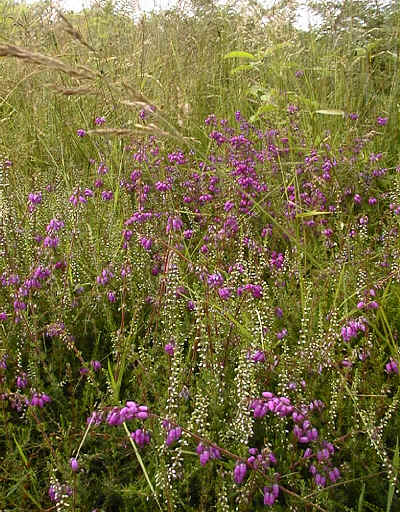 |
Heather and Bell Heather, the
plants perhaps most characteristic of dry, lowland heath in England have colonized many
areas of the project site. Many other characteristic heath
species are also well established.
This heath vegetation has naturally regenerated without the need for
artificial seeding. |
| 2. |
The local environmental conditions have had a considerable impact on the
development of lowland heath habitat on the project site. |
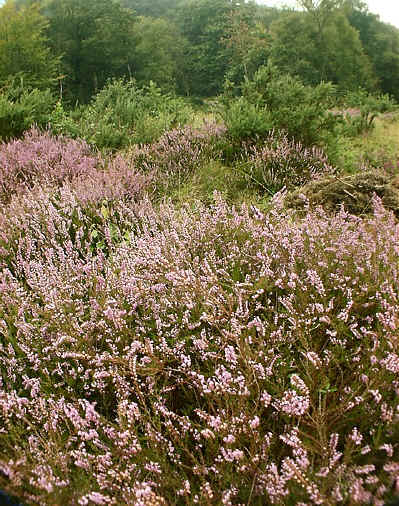 |
The northern
half of the project site is more open than the southern half, with a warmer, drier
microclimate. (Site description here) Sections 7,
8 and 9 in the northern sector, all of which are differently managed, most resembled
lowland heath habitats throughout this six year period. All of these sections rapidly
developed notable quantities of heathers, as well as a variety of other plant species
characteristic of lowland heath. Section 9 (left) on the northern-most border of the project site has
consistently been the section closest to a lowland heath habitat. The management in this
section has consisted of hand weeding. The development of characteristic heath vegetation
in section 9 was very rapid. It far surpassed that of the unmanaged control section (5),
which would be expected to look similar initially.
This all indicates that the local environmental
conditions in the northern half of the project site are more favourable for lowland heath
vegetation. |
|
| 3. |
Different management regimes have selectively favoured different combinations
and abundance of heath (and other) species, resulting in slightly different heath-type
vegetation in different sections. |
|
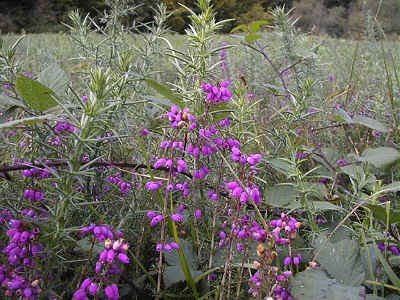 |
Within the
northern-most area of the project site, which is most favourable for heath regeneration,
typical heath species occur with varying abundance in differently managed sections. For example, Bell Heather is most abundant in section 7,
Heath Speedwell is most abundant in section 6 and Tormentil is most abundant in section 8.
|
|
| 4. |
Hand weeding is ineffective as a means of maintaining lowland heath
vegetation and preventing succession to woodland on anything but the smallest of areas.
The amount of labour needed to effectively control succession by hand weeding alone is
simply uneconomic. |
|
 |
By 2001, six years into the
experiment, succession to woodland was well under way in section 9. Silver Birch was the
second most dominant species after bramble, reaching heights of over 1.5 metres. Other
tree seedlings such as cherry, willow and Rowan were also well established and many of
these were beyond pulling out by hand at this stage. Bramble occurred over the majority of
the section and much of the regenerating Heather had become coarse and rank. Section 9 is the largest section on the project site, with an area of
approximately 0.3 hectares, as oppposed to approximately 0.1 hectares for section 5. Hand
weeding was deliberately assigned to this largest section to test whether such management
would be effective on an area likely to be much smaller than any other site selected for
lowland heath restoration. |
|
| 5. |
Natural succession to woodland was taking place in the control section (no
management) within the short time span of 6 years. |
|
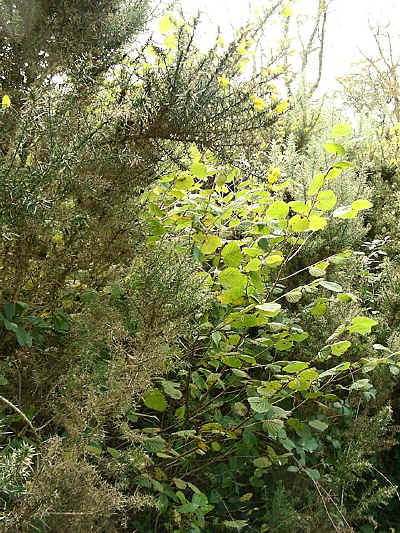 |
Hand weeding did retard
succession to some extent in section 9. By comparison,
the control section in 2001 was a tangled, impenetrable mass of European Gorse, young
trees and brambles reaching up to 4 metres in height in places.
Virtually all of the Heather and Bell Heather which had colonized
the control section initially, had been eliminated by this time through lack of ground
level light.
Natural succession had effectively already eliminated any chance of
establishment of a heath habitat within the short space of 6 years. |
| 6. |
Annual cutting controls the height of tree seedlings. It may also slightly
inhibit their establishment. |
|
 |
Annual cutting prevented tree
seedlings from reaching any significant height. Silver Birch
was generally less abundant in annually cut sections than in the control (5) and hand
weeded sections (9). It occurred with percentage frequencies of from less than 10%, to 45%
in annually cut sections in 2001. These frequencies had not changed significantly from the
preceding year. In contrast, in section 9 (left) the percentage frequency of Silver Birch had reached 70%. |
| . |
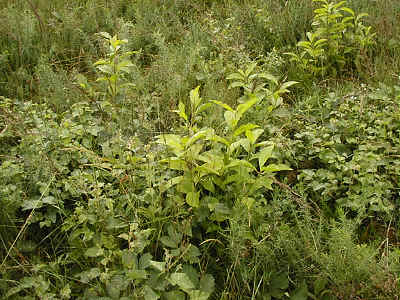 |
Autumn cut sections appeared
to have more tree seedlings than spring cut sections. This may simply be a result of the
fact that the tree seedlings in autumn cut sections were much larger and more prominent at
the time of sampling than the tree seedlings in the spring cut sections. (Tree seedlings
in spring cut sections would have been cut to ground level not long before sampling and so
would not have had much time to regenerate.) |
|
| 7. |
Spring cutting appears to favour the development of Heather and Bell Heather. |
|
 |
Sections 1 -
4 form the southern area of the triangular Heathland Restoration Project area and are
quite different to the rest of the project site. All four strips are bounded by woodland,
with the increasingly tall control strip (section 5) to their north. These four sections
therefore have a very different microclimate and environmental conditions to the more
northerly sections 6 - 9. The conditions in
this southerly area are so different that it was doubted whether this part of the
Heathland Restoration Project site would ever regenerate as heathland. It is therefore
notable that heathers first appeared in 1999 in both spring cut sections on this
southern side of the project area, but had still not established in the neighbouring
autumn cut strips by 2001.
The much lower height of the dominant vegetation over the summer growing season results in
less competition for light at ground level. This promotes seedling establishment
generally, as well as the development of small ground level herbs. |
|
| 8. |
Visual indications suggest that spring cutting is negatively affecting spring
flowering plants such as Bluebells. |
|
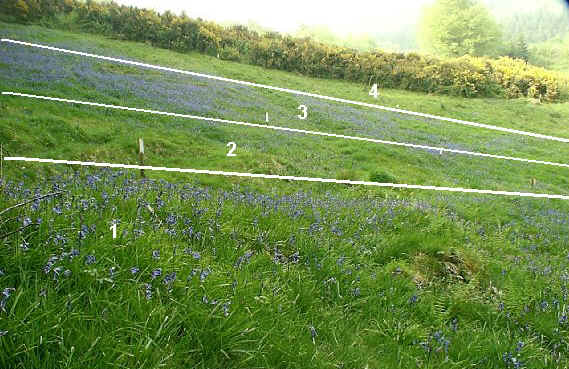 |
Spring
brushcut strips (2 and 4 left -
the white lines have been superimposed to aid the viewer) appeared to have fewer bluebells than those cut in the
autumn, although as the spring-flowering Bluebells have all died back by the time of the
summer survey, their true abundance is not reflected in the survey data. Bluebells flower early in spring, using stored reserves from
underground bulbs. It is likely that cutting soon after flowering prevents them from
replenishing those reserves for the following year. |
|